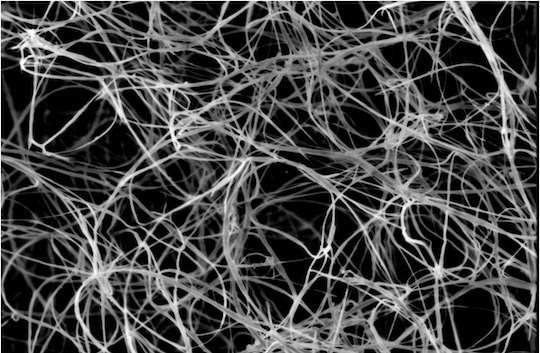Researchers from Rice University claim that processing boron nitride nanotubes used to be challenging, but not anymore.
 A tangle of unprocessed boron nitride nanotubes seen through a scanning electron microscope. Rice University scientists introduced a method to combine them into fibers using the custom wet-spinning process they developed to make carbon nanotube fibers. Image Credit: Pasquali Research Group.
A tangle of unprocessed boron nitride nanotubes seen through a scanning electron microscope. Rice University scientists introduced a method to combine them into fibers using the custom wet-spinning process they developed to make carbon nanotube fibers. Image Credit: Pasquali Research Group.
Professors Matteo Pasquali and Angel Martí, along with their team of researchers, have simplified the handling of the highly valuable nanotubes, making them more suited for use in large-scale applications including electronics, aerospace, and energy-efficient materials.
According to the study’s findings published in Nature Communications, boron nitride nanotubes, also known as BNNTs, can self-assemble into liquid crystals when exposed to certain circumstances, particularly concentrations of chlorosulfonic acid that are greater than 170 parts per million by weight.
Compared to the often-tangled nanotubes that develop in solution, these liquid crystals are made of aligned BNNTs, which are much simpler to handle. The liquid crystalline solutions were then used in the lab to create fibers and films.
BNNT fibers are attractive for the manufacture of a variety of products, with applications that range from wearables to aerospace vehicles.
Angel Martí, Professor, Chemistry, Bioengineering, and Materials Science and NanoEngineering, Rice University
Similar to carbon nanotubes, boron nitride nanotubes have hexagonal lattices made up of alternating boron and nitrogen atoms rather than carbon. Both types of nanotubes are robust, but BNNTs are superior electrical insulators and chemically and thermally stable in the air up to 900 °C (1,652 ℉), unlike electrically conductive carbon nanotubes.
The scientists had to make sure their nanotubes were clean to create liquid crystals. Sadly, the majority of the pollutants were boron nitride particles that posed a threat to clogging the system.
Early BNNT samples contained lots of non-nanotube boron nitride structures. They were either chemically bound to the BNNTs or just physically adhered in a way that prevented BNNTs from dispersing in acid and aligning at higher concentrations.
Cedric Ginestra, Study Lead Author and Graduate Student, Rice University
Ginestra added, “It is difficult to separate these boron nitride allotropes from BNNTs, and hard to even measure their concentration. All the different types of boron nitride appear identical by basically every quantitative technique that we have tried so far.”
They were able to produce superior batches of BNNTs by working with their supplier to refine their BNNT purification process for the creation of liquid crystalline solutions and by utilizing a purification technique created in the Pasquali lab, he added.
The Pasquali group was prepared to swiftly modify their wet-spinning methods for carbon nanotube fibers to manufacture the first boron nitride threads once adequate material was produced.
“There are reports of others taking solid puffs of BNNTs and stretching and twisting them to make a yarn, but that is very different from our process. Our goal was to make a very highly aligned fiber because the properties are better along the length of the nanotubes”, stated Ginestra.
He added that since the nanotubes within liquid crystals are already aligned, they make the best precursor for fibers. The liquid crystals’ birefringence, a phenomenon wherein crystals split light like prisms even though they appear to be transparent, allowed scientists to identify the BNNT alignment in them under the microscope.
The films also showed how BNNT solution processing can use techniques created for carbon nanotubes, according to Ginestra. Future electronics can benefit from the usage of such transparent thin sheets.
Ginestra further added, “The BNNT film and fiber properties will improve as the material and our understanding of the liquid crystalline solution improves.”
Martí observed that BNNT films might be helpful as corrosion protection, antifouling coatings, and ultraviolet light filters.
Rice graduate students Cecilia Martínez-Jiménez and Oliver Dewey, alumni Ashleigh Smith McWilliams, Robert Headrick and Dmitry Kosynkin, and postdoctoral researcher Jesus Acapulco; graduate student Asia Matatyaho Ya’akobiand professor emeritus Yeshayahu Talmon of the Technion-Israel Institute of Technology and the Russell Berrie Nanotechnology Institute, Haifa, Israel; Lyndsey Scammell and Michael Smith of BNNT LLC, Newport News, Virginia; former Rice postdoctoral researcher Daniel Marincel, now an assistant professor at the Rose-Hulman Institute of Technology, Terre Haute, Indiana; senior researcher Cheol Park of the NASA Langley Research Center, Hampton, Virginia; and associated research fellow Sang-Hyon Chuof the National Institute of Aerospace, Hampton, Virginia are the co-authors of the study.
Martí is a professor of nanoengineering, materials science, bioengineering, and chemistry. Pasquali is the A.J. Hartsook Professor of Chemical and Biomolecular Engineering and is a professor of chemistry and material science and nanoengineering. He is also the director of the Carbon Hub.
A NASA Space Technology Research Fellowship (NNX14AL71H), the National Science Foundation (1807737, 2108838), the Welch Foundation (C-1668), the National Council of Science and Technology (CONACyT) Mexico (710115), Air Force Office of Scientific Research (FA9550-18-1-0014, FA9550-19-1-7045), the United States-Israel Binational Science Foundation (2016161), Office of Naval Research Small Business Innovation Research grant (N68335-19-C-0560) and the Department of Energy (DE-AR0001015) supported the research.
Journal Reference:
Ginestra, C. J. S., et al. (2022) Liquid crystals of neat boron nitride nanotubes and their assembly into ordered macroscopic materials. Nature Communications. doi.org/10.1038/s41467-022-30378-5.